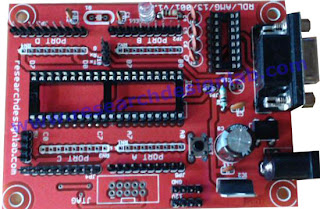Overview
PICs are popular with both industrial developers
and hobbyists alike due to their low cost, wide availability, large user base,
extensive collection of application notes, availability of low cost or free
development tools, and serial programming (and re-programming with flash
memory) capability. They are also commonly used in educational programming .
Features:
- PIC Development Board for Microchip PIC Series.
- On board Regulated Power- Optional Supply 5v,12v supplys
- Easy to test with Burg Connecters wires
- An RS232 Serial Port
- Compatable for USB Power supply.
- DC Power Supply Connector(12v Ac or Dc)
- On board programming ISP.
- 4 Intruupt Switchesr/keypad
- Example Programs for LED,LCD,RS232 ,Matrix Key Pad, ADC
Circuit Diagram
For Sample Codes Click Here








